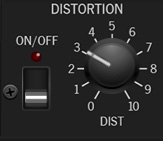
PS-20 includes three great-sounding onboard effects - distortion, and modulation echo, and a reverb. It's really like having more, because the mod echo mod controls allow flanging, chorus, and combinations thereof.
Note that the order of the signal chain is as it appears on the front panel - Distortion>Mod/Echo>Reverb. This makes sense, because distortion almost always sounds awful following time-based effects.
Distortion

This one is super simple. Turn it on, crank up the knob and distort! As discussed in the Highpass and Lowpass Filter section, the Distortion effect is a single distortion generator, so any time multiple chord notes are played through it, they'll be distorted as a single entity. Conversely, the filter section Drive knobs overdrive each polyphonic note individually, so you won't hear (big word alert) intermodulation distortion between notes. Experiment!
On/Off- Enables and disables distortion effect.
Dist- Sets the overall amount of distortion. This guy can get pretty loud, so watch with levels - just keep an eye on the retro-cool VU meter, and adjust the master Volume knob if necessary.
Mod/Echo

On/Off- Enables and disables Mod/Echo effect.
Sync- Enabling the Sync switch locks the delays time to master tempo. When engaged, the Time knob snaps to note values ranging from 1/64th note triplet to 8 beats. Sync mode locks to the tempo in the top toolbar when using the standalone version or the current project tempo when using the plug-in version in a DAW.
Time knob / LED / digital display- Sets delay time, from 1 to 2000 ms. If the Sync button is enabled, time settings snap to synchronized note values (see Sync switch above). The LED beside it blinky-blinks at the current rate.
Feed Back- Routes the output to the input to set the number of echo repeats.
Dampen- Attenuates high frequencies as the knob amount is increased. Not only does this create more natural sounding decays, it also reduces the "stacking" effect that occurs with high feedback levels.
Mod controls- These allow modulation of the delay time with an internal sine-wave LFO. The addition of time mod enables flanging and chorus effects as well as wilder, swooping pitch effects at more extreme settings.
Mod Rate- Varies the speed of time modulation from 0.15 to 30 Hz.
Mod Depth- Mod depth affects how much the time is varied by.
Creating Flanging and Chorus effects - The primary purpose of the Mod controls are to allow flanging and chorus effects. Flanging and chorus are closely related; the difference is that flanging typically creates metallic and/or jet flyby "whooshing" sounds, whereas chorusing produces a gentle, mildly detuned doubling effect.
To create a flange, set the Time to 15ms or less, Feedback over 70%, slow Mod/Rate, Mod/Depth over 60%, and Dry/Wet to 50%.
To create a chorus effect, set the Time around 20ms, Feedback at 0, Mod/Rate around 0.60 Hz, Mod/Depth 6% (this is actually center knob position), and Dry/Wet to 50%. Click the Spread switch on for a nice stereo chorus.
Spread- Simultaneously subtracts and adds 10ms of delay time to the left and right channels respectively, creating a wide stereo effect. It also prevents echoes from "piling" up in the center of the image. Note that the subtracted and added delay effectively changes the overall delay time setting with each repeat, so long delays combined with high feedback settings can become noticeably off time. If you're using high feedback echoes with many synced repeats, we recommend disabling the Spread switch.
Amount- Balances the level of dry and wet signal. Setting the knob to the center position gives an equal 50/50 balance of wet and dry signal.
Reverb

On/Off- Enables and disables the reverb effect.
Reverb Type- Allows selection of spring- or plate-style reverbs.
Decay- Sets the overall length of reverb; the actual time varies for each type.
Damp- Attenuates high frequencies as the knob amount is increased for more natural reverb sounds.
Amount- Balances the level of dry and wet signal.